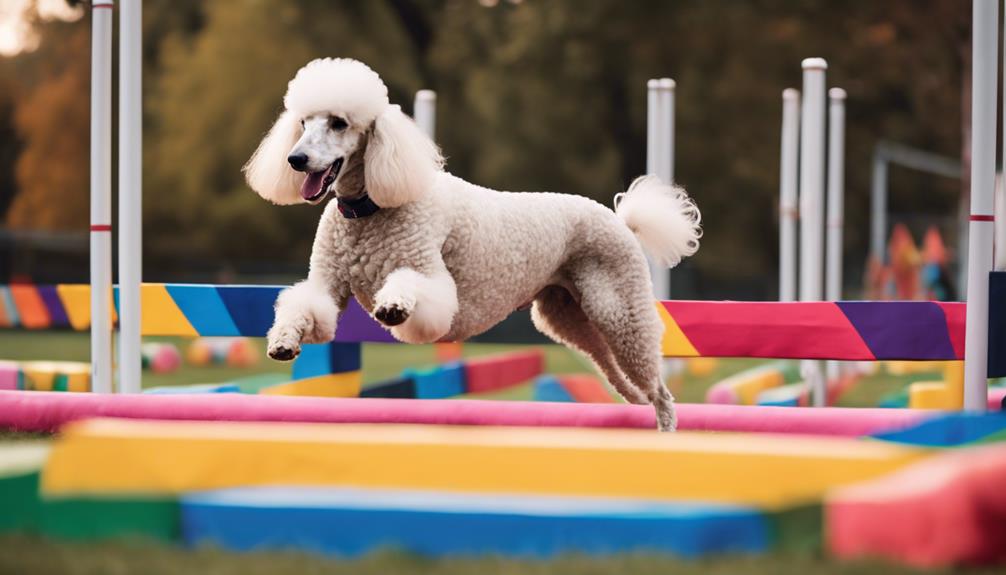They say, "Practice makes perfect." Imagine the thrill of watching your poodle gracefully conquer agility courses with finesse and speed. As you embark on this journey of training your poodle for agility sports, there are essential steps to consider. From mastering basic obedience to tackling challenging obstacles, your poodle has the potential to excel. Stay tuned to discover the secrets to unlocking your poodle's full agility potential and paving the way for a rewarding partnership.
Key Takeaways
- Agility training enhances physical and mental abilities in Poodles.
- Consistent training routines and positive reinforcement are vital for success.
- Building confidence through early training and mental preparation is key.
- Safety considerations and regular practice maintain peak performance in agility sports.
Poodle Agility Training Basics
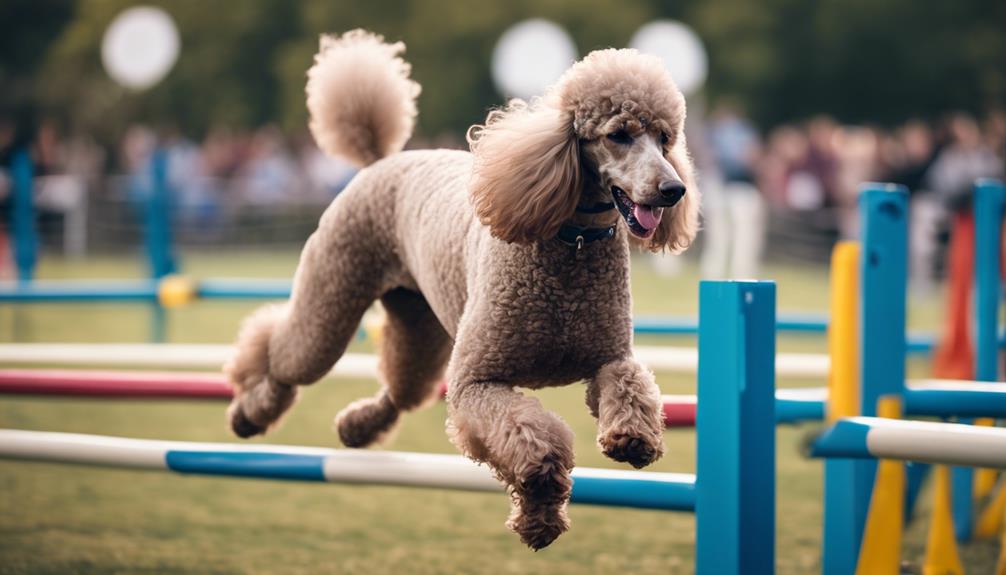
Looking to get started with Poodle agility training? Agility training for your Poodle is not only a fantastic way to keep them physically active but also provides the mental stimulation they crave. When introducing agility training to your Poodle, focus on teaching them to navigate obstacles like jumps, tunnels, weave poles, and contact obstacles. Positive reinforcement is key in this process. Poodles respond well to praise, treats, and play as rewards for completing tasks successfully.
Consistency is vital in Poodle agility training. Establish a routine and stick to it. Poodles thrive on predictability, so regular training sessions will help them understand what is expected of them. By maintaining a consistent approach, you are setting your Poodle up for success in agility sports.
Physical Conditioning for Poodles
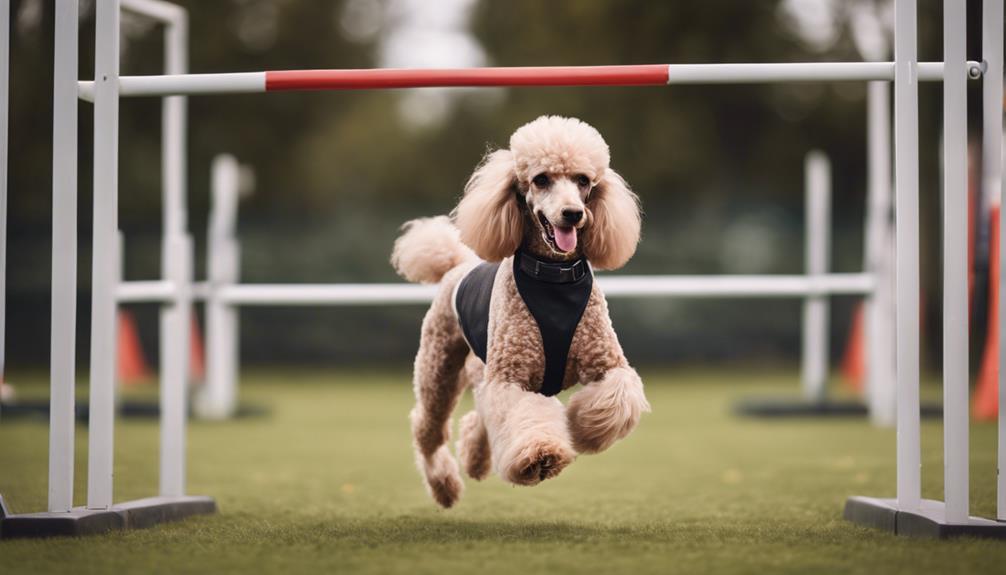
To prepare your Poodle for agility sports, focus on exercise to build muscle tone, cardio to boost endurance, and stretching for flexibility. These elements are key in enhancing your Poodle's physical conditioning for peak performance. By incorporating a balanced regimen of these activities, you can help your Poodle stay healthy, agile, and ready for agility challenges.
Exercise for Muscle Tone
Engaging in regular agility training sessions with your Poodle will significantly enhance their muscle tone and overall physical conditioning. Agility exercises such as jumps, tunnels, and weave poles work various muscle groups, promoting strength, endurance, coordination, and flexibility in your Poodle. These activities not only help in building muscle mass but also aid in maintaining a healthy weight. By incorporating agility training into your Poodle's routine, you provide them with a fun and effective way to stay physically fit and improve their muscle tone. Remember, consistency is key when it comes to seeing progress in your Poodle's muscle tone. So, enjoy the training sessions with your furry friend and watch them thrive!
Cardio for Endurance
For improving your Poodle's endurance and physical conditioning, incorporating cardio exercises like running, swimming, and fetch is crucial. Regular cardio sessions not only enhance cardiovascular health but also build stamina in Poodles, preparing them for the demands of agility sports. Interval training can be particularly effective in challenging your Poodle and improving its endurance levels. Additionally, agility training serves as a fun way to enhance endurance while engaging your Poodle's mind and body. Consistent cardio routines are key to ensuring your Poodle is well-prepared for the physical rigors of agility sports. Check out the table below for some examples of cardio exercises you can incorporate into your Poodle's training regimen:
| Cardio Exercise | Description |
|---|---|
| Running | Great for building speed |
| Swimming | Low-impact, full-body workout |
| Fetch | Engages both physical and mental abilities |
Stretching for Flexibility
Improving your Poodle's flexibility through regular stretching exercises is essential for enhancing its agility performance and overall physical conditioning. Stretching not only increases flexibility but also helps prevent injuries and improves the range of motion in your Poodle's joints. Focus on stretches that target the neck, shoulders, spine, hips, and legs to ensure a well-rounded routine. Incorporate dynamic stretches before training sessions to warm up the muscles and static stretches after to cool down and lengthen the muscles. By implementing a consistent stretching regimen, you are not only aiding in your Poodle's agility performance but also supporting its physical well-being. Remember, flexibility is a key component in maintaining optimal condition for agility sports.
Mental Preparation for Poodles
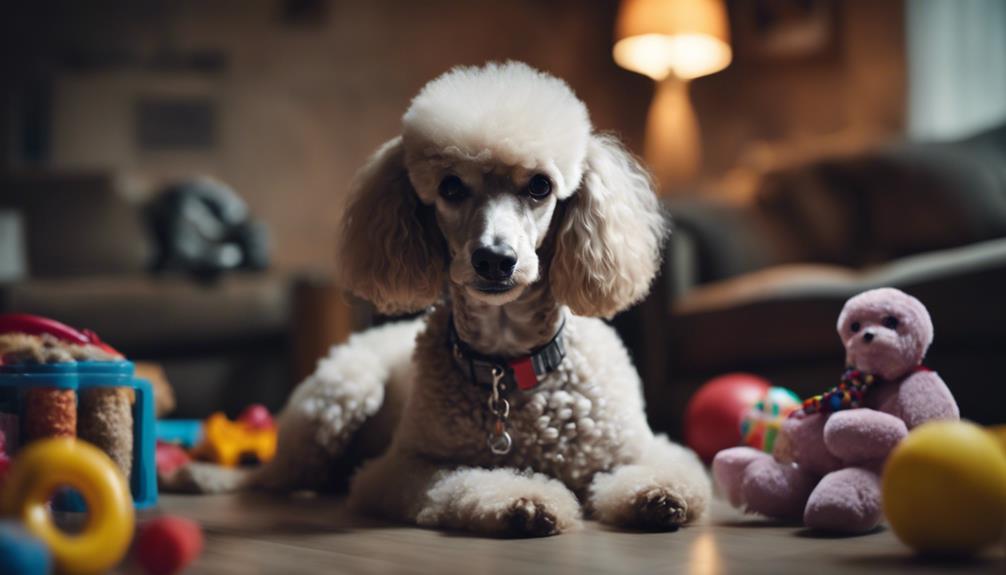
When preparing your poodle mentally for agility sports, focus on building their confidence through positive reinforcement. Engage your poodle in activities that stimulate their mind to keep them attentive and motivated during training sessions. Introducing problem-solving tasks and gradually exposing them to various distractions can improve their performance in agility sports.
Focus and Attention
Enhancing focus and attention skills in your Poodle is crucial for excelling in agility sports training. To help your Poodle improve in this area, consider the following:
- Engage your Poodle in interactive games that require focus, such as hide-and-seek with treats.
- Incorporate obedience training into your Poodle's routine to strengthen their ability to concentrate on commands.
- Use positive reinforcement techniques to reward your Poodle for maintaining focus during training sessions.
Confidence Building Exercises
Building confidence in your Poodle for agility sports involves engaging in positive reinforcement training to help them tackle new obstacles with mental preparedness. Start by introducing confidence-building exercises such as focus and attention drills. These exercises can include setting up small agility obstacles and rewarding your Poodle for successfully navigating them. Utilize interactive play and problem-solving games to boost mental agility and resilience. Creating a safe and supportive training environment is crucial for your Poodle to feel secure while learning. Remember, patience and consistency are key in developing your Poodle's confidence. By incorporating these practices into your training routine, you are setting the stage for a confident and mentally prepared Poodle in agility sports.
Stress Management Techniques
To help your Poodle excel in agility sports, it is essential to equip them with effective stress management techniques for mental preparation. Incorporate visualization techniques to mentally prepare your poodle for agility challenges. Practice deep breathing exercises to help your poodle stay calm and focused during training. Integrate playtime and relaxation into your poodle's routine to reduce stress levels. By implementing these stress management techniques along with positive reinforcement and providing a consistent training environment, you can help your poodle build confidence, reduce anxiety, and perform better in agility sports. Remember, a calm and focused poodle is more likely to enjoy the training process and excel in agility competitions.
Start Training Poodles Early
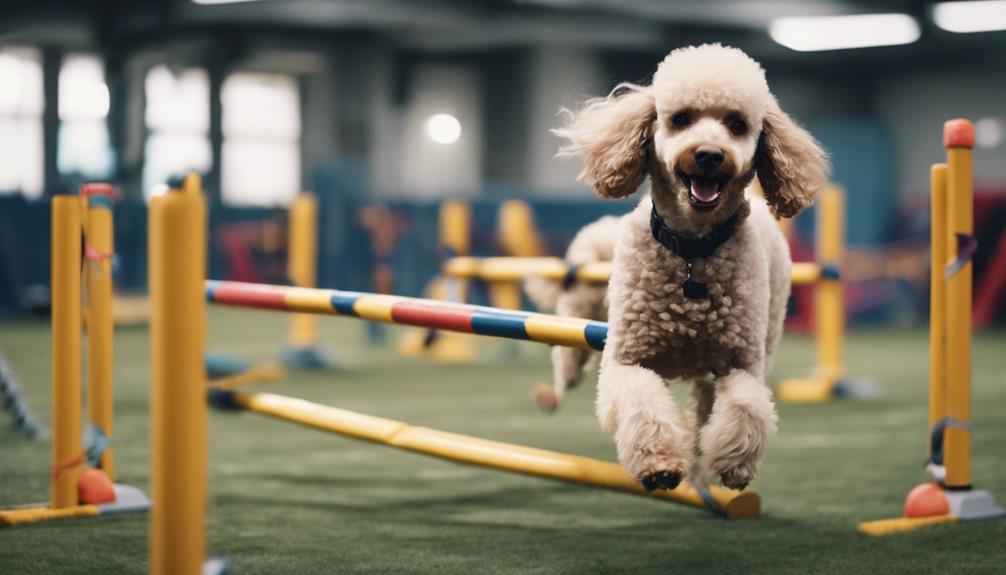
To foster a successful agility journey for your poodle, initiating training at an early age is imperative. Young dogs are like sponges, eagerly soaking up new information and experiences. Starting early allows them to grasp basic skills, boosting their confidence and coordination. Early training sets the stage for a solid understanding of dog agility training concepts. By introducing agility exercises at a young age, your poodle becomes familiar with the equipment and obstacles they will encounter. This familiarity not only builds their confidence but also enhances their ability to navigate the challenges of agility courses. Moreover, early exposure to agility training instills a sense of enthusiasm and joy in your poodle, making the learning process more engaging and enjoyable. Remember, the key to success in agility sports lies in laying a strong foundation through early training.
Introducing Contact Obstacles
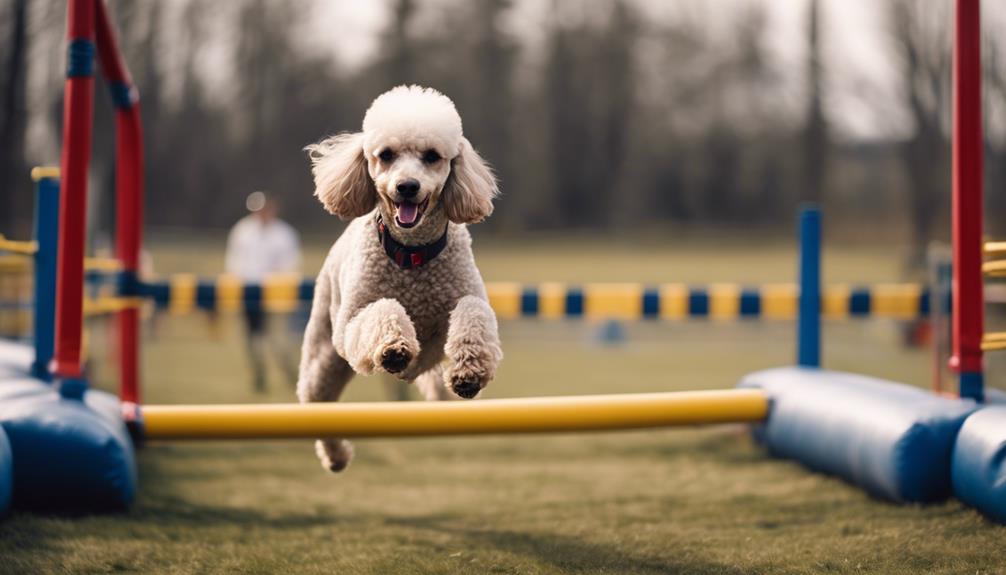
When introducing contact obstacles to your poodle for agility training, emphasize the importance of proper paw placement on these specific spots for successful completion. Contact obstacles such as the A-frame, teeter-totter, and dog walk require precise footwork from your poodle to navigate them effectively. To help your poodle master these obstacles, consider the following:
- Use treats strategically: Using treats on the contact zone can encourage your poodle to make correct paw placements on the obstacles.
- Provide positive reinforcement: Positive reinforcement, such as praise and rewards, is crucial in reinforcing the desired behavior of correctly engaging with the contact obstacles.
- Focus on mastering each obstacle: Take the time to ensure your poodle thoroughly understands and can navigate each contact obstacle confidently before moving on to the next one.
Teaching Poodles to Jump
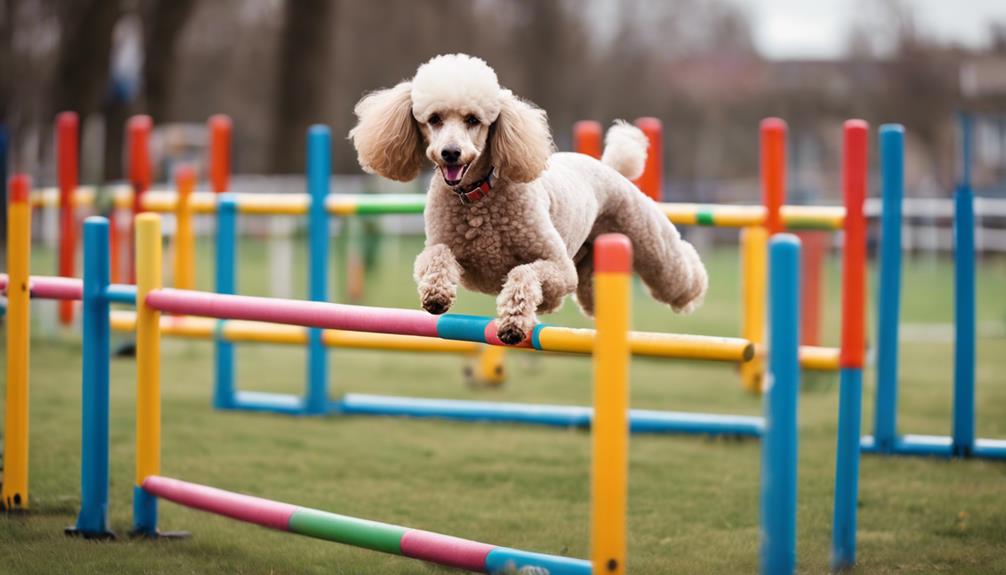
When teaching your Poodle to jump, focus on the basics of jump height and form techniques. Start with low jumps and gradually increase the height as your Poodle gains confidence. Remember to reward good jumps with treats and praise to reinforce positive behavior.
Jump Height Basics
Start by gradually increasing the jump height for your poodle to build confidence and skill in agility training. To help your poodle master the jumps, consider the following:
- Use adjustable jump bars: Start with lower heights and gradually raise them as your poodle gains confidence.
- Incorporate positive reinforcement: Encourage your poodle with treats and praise to make the jumping experience enjoyable.
- Maintain a safe landing area: Ensure the area where your poodle lands is cushioned to prevent injuries and provide a comfortable landing spot.
Jump Form Techniques
To teach your poodle proper jumping form, begin with low jumps to prevent stress on their joints. Use positive reinforcement, such as treats and praise, to encourage them to jump with the correct technique. Gradually increase the jump height to challenge your poodle and enhance their jumping abilities. Focus on teaching them to jump with all four paws together for safety and efficiency. Ensure regular practice sessions to help your poodle develop strength and confidence in their jumping skills. By following these jump form techniques and being consistent in your training, your poodle will progress steadily in agility sports. Remember, patience and regular practice are key to mastering the art of jumping for your poodle's success.
Trying Tunnels With Poodles
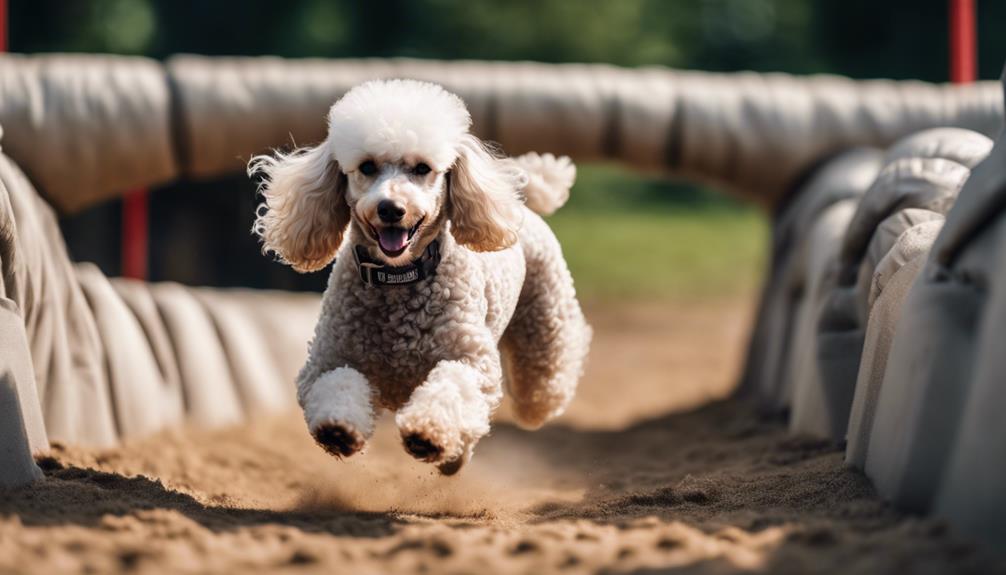
Introducing poodles to tunnel challenges requires a patient approach that focuses on building confidence and skill gradually. These intelligent and agile dogs can excel in tunnel challenges with the right training. To help your poodle navigate tunnels successfully, consider the following:
- Start with short straight tunnels: Begin by introducing your poodle to shorter, straight tunnels to help them get accustomed to the task gradually.
- Gradually progress to curved or longer tunnels: Once your poodle gains confidence with straight tunnels, gradually introduce them to curved or longer tunnels to enhance their agility skills.
- Use treats or toys for motivation: Encourage your poodle through the tunnel with treats or toys to make the experience positive and rewarding.
Weave Poles Training for Poodles
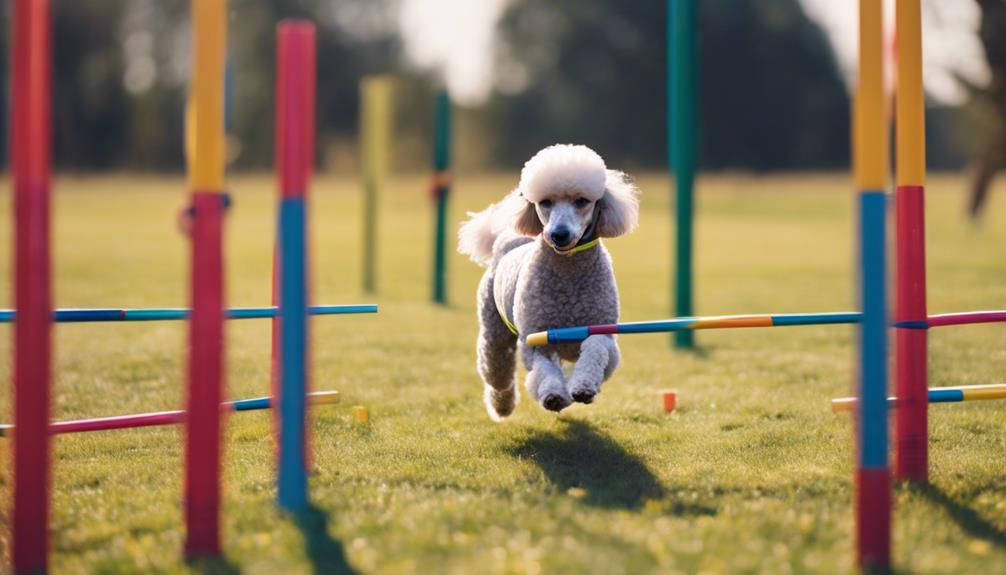
When training your Poodle for agility sports, mastering weave poles is a key skill that requires patience and consistency. Weave poles training for Poodles involves teaching them to weave in and out of a series of poles in a zigzag pattern. To excel at this, your Poodle needs to learn the footwork and coordination necessary to navigate the weave poles efficiently. Start with a few poles close together and then gradually increase the distance as your Poodle improves in weaving.
Utilize verbal cues like 'weave' or 'in-out' to guide your Poodle through the weave poles effectively. Remember to practice short training sessions regularly to help your Poodle master the weaving skill with confidence and precision. By staying consistent, patient, and offering clear verbal cues, you will aid your Poodle in becoming a skilled weaver on the agility course.
Poodles on the Pause Table
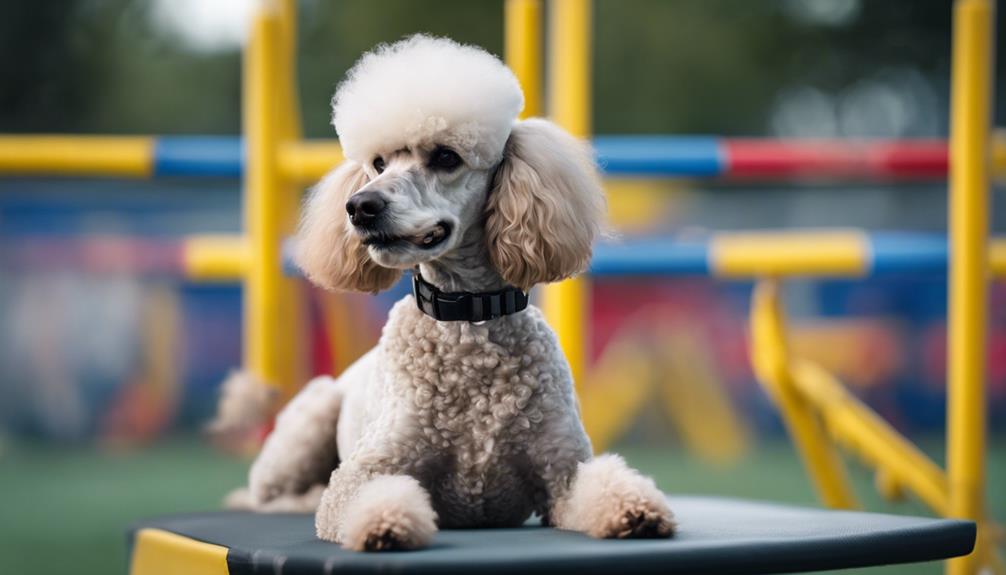
Calmly guide your Poodle onto the pause table, reinforcing confidence and focus as they learn to pause effectively during agility training. The pause table is a crucial element in agility courses, testing your Poodle's ability to obey commands and display control. Here are some tips to help your Poodle excel on the pause table:
- Use Positive Reinforcement: Encourage your Poodle with treats and praise when they successfully pause on the table.
- Practice Regularly: Incorporate pause table exercises into your training routine to help your Poodle feel more comfortable and confident.
- Work on Focus: Train your Poodle to maintain eye contact and listen for your commands while on the pause table.
Mastering the pause table not only enhances obedience and focus but also lays the foundation for success in agility competitions. With patience and consistent practice, your Poodle will develop the skills needed to ace the pause table and excel in agility training.
Sequence Training for Poodles
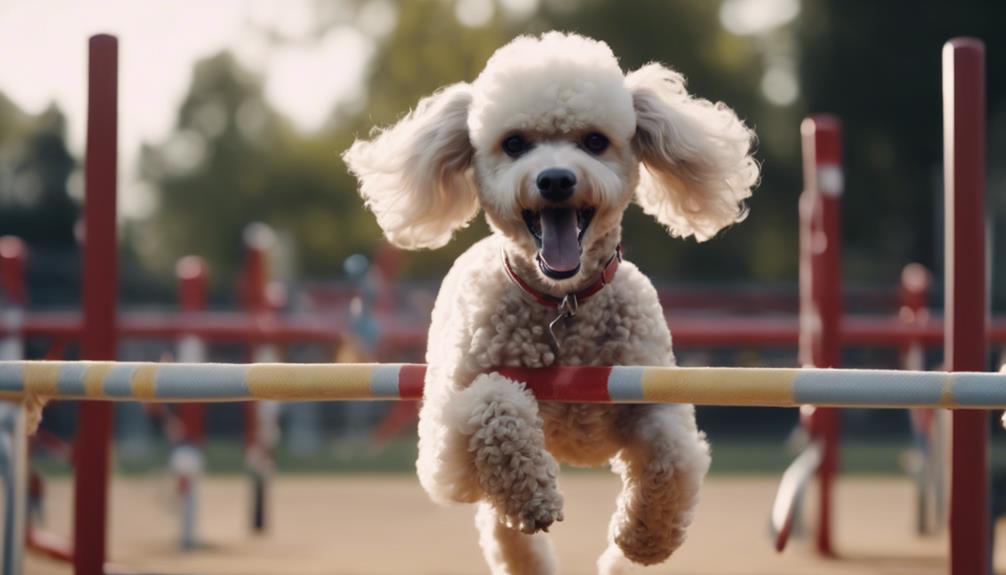
Are your poodle's agility skills ready to advance to the next level with sequence training? Sequence training for poodles involves teaching them to navigate a series of agility obstacles in a specific order. This type of training is crucial as it helps poodles learn how to smoothly transition between different challenges like jumps, tunnels, and weave poles. By practicing sequences, poodles develop essential skills such as focus, coordination, and problem-solving abilities needed for agility competitions.
Handlers play a significant role in guiding poodles through predetermined courses, focusing on speed, accuracy, and effective communication with their furry companions. Consistent practice is key to mastering complex sequences and enhancing performance in agility sports. Remember to use positive reinforcement techniques during training sessions to encourage your poodle's progress and boost their confidence.
Troubleshooting Poodle Behavior
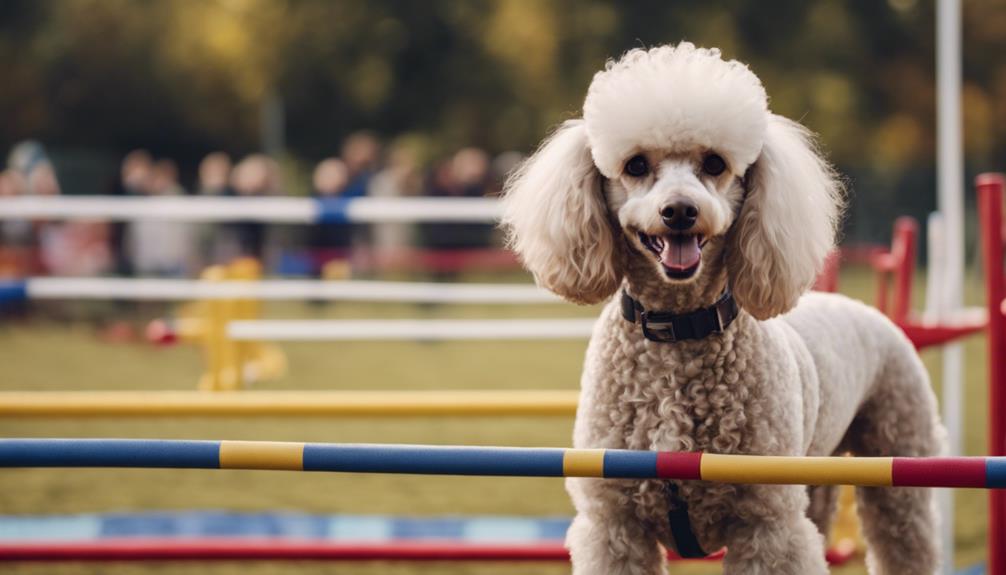
To effectively troubleshoot poodle behavior in agility training, observe and interpret their responses to obstacles with a keen eye for subtle cues. Poodles, being intelligent and sensitive, require patience and positive reinforcement to excel in agility sports. Here are some tips to help you navigate any behavior issues:
- Gradual Exposure: Address any fear or hesitation in your Poodle by gradually introducing them to agility obstacles, allowing them to build confidence at their own pace.
- Consistent Rewards: Focus on building your Poodle's confidence by providing consistent and rewarding training experiences, reinforcing positive behaviors during agility training sessions.
- Body Language Awareness: Watch for body language cues in your Poodle to understand their comfort level. Adapt your training approach based on their signals to create a more supportive environment for learning.
Agility Equipment for Poodles
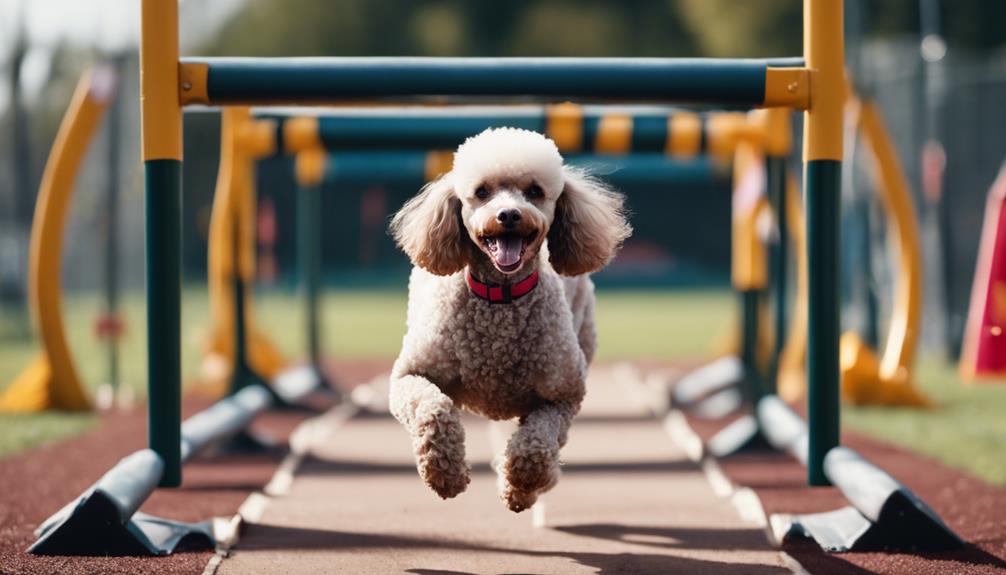
When choosing agility equipment for your Poodle, it's crucial to consider their size and skill level. Opt for adjustable jumps, weave poles, tunnels, A-frames, dog walks, and pause tables designed to suit your Poodle's specific needs. These pieces of equipment not only enhance your Poodle's agility training but also prioritize their safety and overall performance.
Essential Agility Gear
For optimal agility training with your poodle, acquiring essential gear is crucial. When preparing for agility sports, consider the following items to enhance your training sessions:
- Adjustable Collars: Ensure a secure fit for your poodle to prevent any accidents during agility drills.
- Lightweight Leashes: Provide freedom of movement while maintaining control over your poodle's actions.
- Agility Tunnels and Jumps: Essential equipment for practicing jumping, tunnel running, and enhancing overall agility skills.
These items, combined with treats for motivation, will create a conducive environment for your poodle to learn and excel in agility sports. Remember, the right gear can make a significant difference in your poodle's agility training progress.
Safety Considerations
Ensuring the safety of your poodle during agility training involves selecting appropriately sized and secure equipment to prevent injuries. When setting up your agility course, consider using adjustable jump bars at lower heights to help your poodle build confidence in jumping. Introduce weave poles gradually to assist your poodle in mastering the weaving technique. Remember, it's essential to supervise your poodle on contact obstacles like the A-frame to ensure proper form and safety. Below is a table that outlines key safety considerations when using agility equipment for your poodle:
| Equipment | Safety Considerations |
|---|---|
| Adjustable Jump Bars | Start at lower heights for confidence building |
| Weave Poles | Introduce gradually to help your poodle master weaving |
Agility Competitions for Poodles
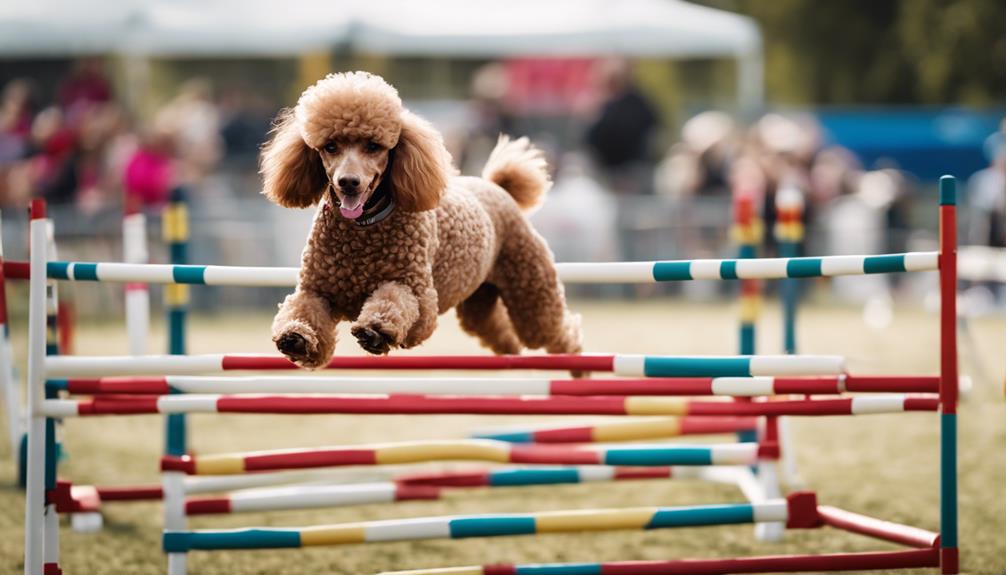
To excel in agility competitions with your Poodle, understanding the different classes and course elements is essential. Poodles, with their intelligence and agility, can participate in various agility competitions tailored to their size divisions – standard, miniature, or toy. These events often feature challenging agility courses designed with elements like jumps, tunnels, weave poles, and contact obstacles to test your Poodle's skills. When competing, your Poodle can enter different height divisions based on their size and agility level, ensuring fair play and competition. The athleticism and enthusiasm of Poodles make them ideal contenders for these competitive events, where speed, accuracy, and teamwork are put to the test. Remember, each competition is a chance for you and your Poodle to showcase your bond and agility prowess, so practice, patience, and persistence are key in preparing for these thrilling events.
- Standard, miniature, or toy size divisions offer diverse opportunities for Poodles in agility competitions.
- Agility courses feature jumps, tunnels, weave poles, and contact obstacles to challenge your Poodle's abilities.
- Competitions test speed, accuracy, and teamwork, highlighting the athleticism and enthusiasm of Poodles.
Maintaining Poodle Agility Skills
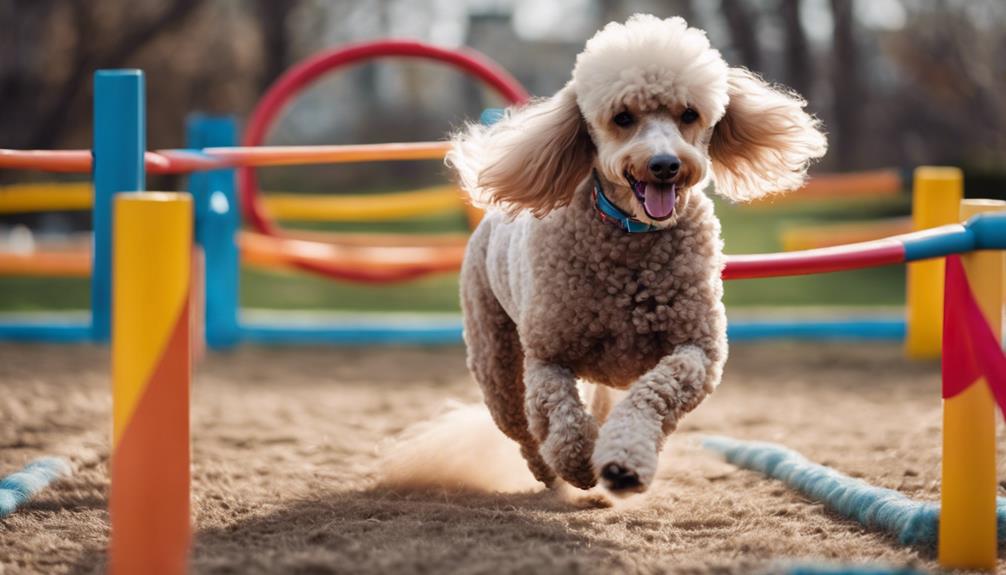
How can you ensure your Poodle maintains peak agility skills for competitions and training? Regular agility training is essential to keep your Poodle in top shape. Practice weaving through poles, jumping over hurdles, and navigating obstacles to maintain their agility skills. Introduce varied agility courses to challenge and improve their abilities continuously. Incorporating agility into your Poodle's routine not only enhances their physical fitness but also provides mental stimulation. Positive reinforcement is crucial during training sessions to keep your Poodle motivated and enthusiastic. Reward good performance with treats or praise to reinforce their agility skills positively. Consistency in training and using rewards will help sustain your Poodle's interest and performance in agility sports. By dedicating time to agility training, you'll ensure that your Poodle remains sharp, agile, and ready for any competition or training session.
Frequently Asked Questions
Can Poodles Do Agility?
Yes, poodles can excel in agility sports due to their intelligence and athleticism. With proper training, equipment, basic commands, mental stimulation, bonding opportunities, and safety precautions, you can help your poodle thrive in agility activities.
What Age Should Dogs Start Agility Training?
At around 1 to 2 years old, your poodle can begin agility training. Before leaping into it, ensure they master basic obedience and consult a vet. Avoid intense workouts until they're fully grown. Get ready for a fun, rewarding journey ahead!
How Do I Start My Dog in Agility?
To start your dog in agility, begin by choosing equipment wisely and finding a trainer. Set clear goals, focus on building confidence, practice obedience, and incorporate play in your training sessions. Enjoy the journey!
How Do I Get My Dog in Shape for Agility?
To get your dog in shape for agility, focus on conditioning exercises, a nutrition plan, mental preparation, consistency, patience, building confidence, and reward-based training techniques. Remember, progress takes time, but the journey with your Poodle is rewarding.
Conclusion
Now that you've laid the groundwork for agility training with your poodle, remember that practice makes perfect. Keep up with consistent training sessions, use positive reinforcement, and don't be afraid to try new challenges. Remember, Rome wasn't built in a day, and neither is a champion agility poodle! Keep up the good work and soon enough, you'll be jumping through hoops with your furry athlete like a pro. Happy training!
